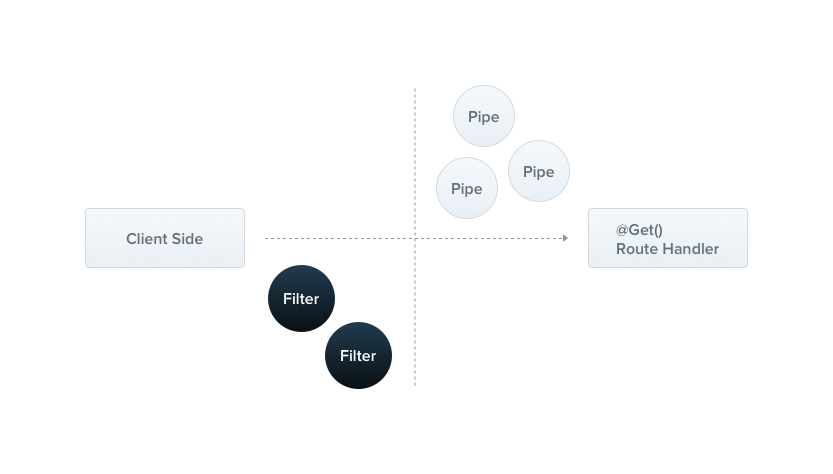Nest 框架内部实现了一个异常处理层,专门用来负责应用程序中未处理的异常。

默认情况未处理的异常会被全局过滤异常器 HttpException 或者它的子类处理。如果一个未识别的异常(非 HttpException 或未继承自 HttpException)被抛出,下面的信息将被返回给客户端:
{
"statusCode": 500,
"message": "Internal server error"
}
¶基础异常
我们可以从控制器的方法中手动抛出一个异常:
@Get()
async findAll() {
throw new HttpException('Forbidden', HttpStatus.FORBIDDEN);
}
客户端将收到如下信息:
{
"statusCode": 403,
"message": "Forbidden"
}
当然你也可以自定义返回状态值和错误信息:
@Get()
async findAll() {
throw new HttpException({
status: HttpStatus.FORBIDDEN,
error: 'This is a custom message',
}, 403);
}
¶异常的级别
比较好的做法是实现你自己想要的异常类。
export class ForbiddenException extends HttpException {
constructor() {
super('Forbidden', HttpStatus.FORBIDDEN);
}
}
然后你就可以手动在需要的地方抛出它。
@Get()
async findAll() {
throw new ForbiddenException();
}
¶HTTP 异常
Nest 内置了以下集成自 HttpException 的异常类:
-
BadRequestException
-
UnauthorizedException
-
NotFoundException
-
ForbiddenException
-
NotAcceptableException
-
RequestTimeoutException
-
ConflictException
-
GoneException
-
PayloadTooLargeException
-
UnsupportedMediaTypeException
-
UnprocessableEntityException
-
InternalServerErrorException
-
NotImplementedException
-
BadGatewayException
-
ServiceUnavailableException
-
GatewayTimeoutException
¶异常过滤器
如果你想给异常返回值加一些动态的参数,可以使用异常过滤器来实现。例如下面的异常过滤器将会给 HttpException 添加额外的时间缀和路径参数:
import { ExceptionFilter, Catch, ArgumentsHost, HttpException } from '@nestjs/common';
import { Request, Response } from 'express';
@Catch(HttpException)
export class HttpExceptionFilter implements ExceptionFilter {
catch(exception: HttpException, host: ArgumentsHost) {
const ctx = host.switchToHttp();
const response = ctx.getResponse<Response>();
const request = ctx.getRequest<Request>();
const status = exception.getStatus();
response
.status(status)
.json({
statusCode: status,
timestamp: new Date().toISOString(),
path: request.url,
});
}
}
注意:所有的异常过滤器都必须实现泛型接口 ExceptionFilter
¶参数宿主
上面代码中的 host 参数是一个类型为 ArgumentsHost 的原生请求处理器包装对象。根据应用程序的不同它具有不同的接口。
export interface ArgumentsHost {
getArgs<T extends Array<any> = any[]>(): T;
getArgByIndex<T = any>(index: number): T;
switchToRpc(): RpcArgumentsHost;
switchToHttp(): HttpArgumentsHost;
switchToWs(): WsArgumentsHost;
}
¶绑定过滤器
可以使用 @UseFilters 装饰器让一个控制器方法具有过滤器处理逻辑。
@Post()
@UseFilters(HttpExceptionFilter)
async create(@Body() createCatDto: CreateCatDto) {
throw new ForbiddenException();
}
当然过滤器可以被使用在不同的作用域上:方法作用域、控制器作用域、全局作用域。比如应用一个控制器作用域的过滤器,可以这么写:
@UseFilters(new HttpExceptionFilter())
export class CatsController {}
全局过滤器可以通过如下代码实现:
async function bootstrap() {
const app = await NestFactory.create(ApplicationModule);
app.useGlobalFilters(new HttpExceptionFilter());
await app.listen(3000);
}
bootstrap();
不过这样注册的全局过滤器无法进入依赖注入,因为它在模块作用域之外。为了解决这个问题,你可以在根模块上面注册一个全局作用域的过滤器。
import { Module } from '@nestjs/common';
import { APP_FILTER } from '@nestjs/core';
@Module({
providers: [
{
provide: APP_FILTER,
useClass: HttpExceptionFilter,
},
],
})
export class ApplicationModule {}
¶捕获所有异常
@Catch() 装饰器不传入参数就默认捕获所有的异常:
import { ExceptionFilter, Catch, ArgumentsHost, HttpException, HttpStatus } from '@nestjs/common';
@Catch()
export class AllExceptionsFilter implements ExceptionFilter {
catch(exception: unknown, host: ArgumentsHost) {
const ctx = host.switchToHttp();
const response = ctx.getResponse();
const request = ctx.getRequest();
const status = exception instanceof HttpException
? exception.getStatus()
: HttpStatus.INTERNAL_SERVER_ERROR;
response.status(status).json({
statusCode: status,
timestamp: new Date().toISOString(),
path: request.url,
});
}
}
¶继承
通常你可能并不需要自己实现完全定制化的异常过滤器,可以继承自 BaseExceptionFilter 即可复用内置的过滤器逻辑。
import { Catch, ArgumentsHost } from '@nestjs/common';
import { BaseExceptionFilter } from '@nestjs/core';
@Catch()
export class AllExceptionsFilter extends BaseExceptionFilter {
catch(exception: unknown, host: ArgumentsHost) {
super.catch(exception, host);
}
}